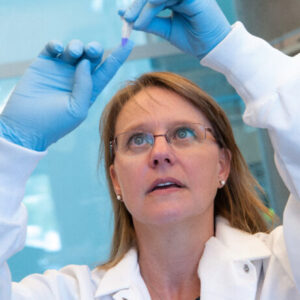
Tara Deans, associate professor in the Price College of Engineering’s Department of Biomedical Engineering, reprograms cells on the genetic level. Using tools known as synthetic gene circuits — custom-designed DNA sequences that can be introduced to a cell and modify its natural genetic instructions — Deans aims to equip the circulatory system with new defenses against cancer.
At the European Laboratory Research and Innovation Group’s Research and Innovation Conference earlier this year, she presented her research on targeting megakaryocytes, the cells that produce clot-forming platelets. While their ability to swarm to an open wound is critical, platelets also have a tendency to cover up free-floating tumor cells, making it harder for the immune system to detect them before they metastasize. Deans hopes that, with some updated protein-making instructions, platelets could be enlisted in destroying those tumor cells instead.
While at the conference, she spoke to the journal BioTechniques about her research and the approaches she uses in the field of synthetic biology.
What do genetic circuits consist of?
In electrical engineering, you have a motherboard to which you add resistors and capacitors with the goal of turning on a lightbulb, for example. We do some very similar things in synthetic biology, except our light bulb is gene expression and our parts are DNA or RNA.
We take these individual gene regulatory parts and engineer them into a larger circuit, so these parts interact with each other. Oftentimes they are inducible, so they can be turned off and turned on to give us dynamic expression in cells. To do that, we can either add small molecules or add light. We can also engineer cells to have autonomous reprogramming, where cells execute their new functions based on their cell state or environment. In my talk, I showed that you can use tissue-specific promoters. These are promoters that only turn on when the cell is, in my case, a megakaryocyte, which is the cell that makes platelets. This lets us know when the cell is ready to become a megakaryocyte in the timeline of differentiation.
What techniques do you use to create genetic circuits?
We can use restriction endonucleases to cut and paste DNA pieces together, or have our DNA parts synthesized by companies. There are activators and repressors, which activate and repress gene expression respectively. We use these basic regulatory parts and piece them together to reprogram cells.
Create a free account at BioTechniques to continue reading Deans’ interview.